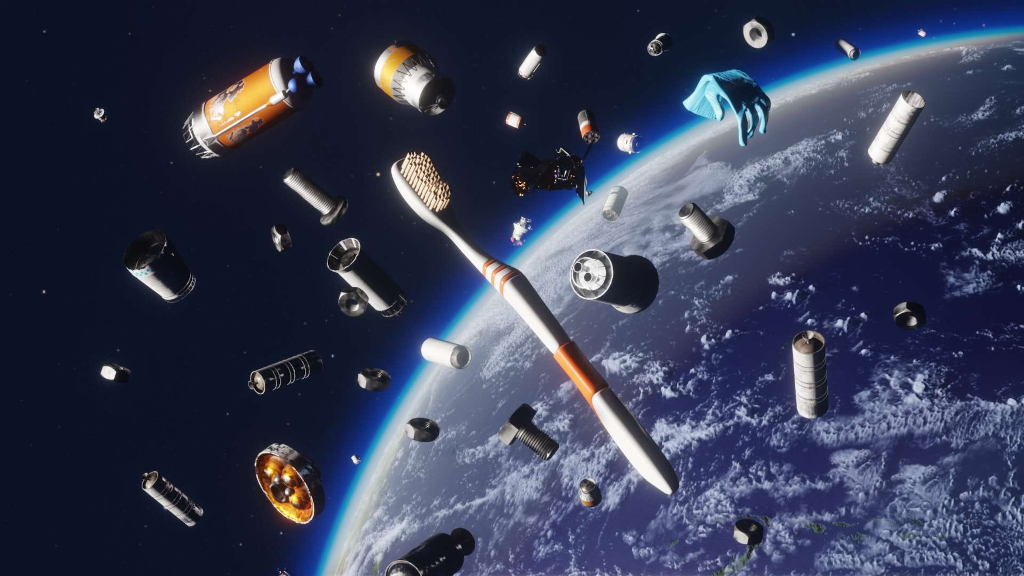Space, the final frontier, the great beyond, the… shockingly cluttered dumping ground for humanity’s discarded space toys. Forget the romantic image of a pristine cosmic void; what we’ve actually created is a high-altitude landfill, where decades of forgotten satellites, exploded rocket stages, and even rogue flecks of paint whiz around at speeds that could turn a pebble into a shotgun blast.
Back in the glory days of the Cold War, the US and the Soviet Union treated space like a shooting range, gleefully blowing up satellites just to prove they could. And why not? It’s not like anyone would have to clean up the mess, except, well, everyone launching anything into orbit for the next few centuries. Fast forward to today, and we’ve got everything from frozen clouds of rocket pee (yes, really) to shards of shrapnel zipping around up there, turning what could be a celestial highway into a demolition derby.
Orbit real estate: A three-tiered trash heap
Like any good zoning system, Earth’s orbital neighbourhoods come with their own class distinctions:
- Low Earth Orbit (200-2,000 km): The equivalent of a downtown studio apartment, compact, crowded, and full of junk that occasionally falls out of the sky. This is where most of the action happens, from the International Space Station dodging debris to Elon Musk’s Starlink satellites playing bumper cars. The good news? Anything down here eventually gets evicted by atmospheric drag, burning up on re-entry in a blaze of toxic glory.
- Medium Earth Orbit (10,000-20,000 km): The suburban sprawl of space, home to GPS satellites and other high-flying tech that can’t be bothered to mingle with the rabble below. Less crowded, but still not exactly pristine.
- Geostationary Orbit (36,000+ km): The gated community of the cosmos, where satellites park themselves for millions of years, blissfully untroubled by the chaos below. If you’re going to litter, this is the place to do it, out of sight, out of mind, and out of everyone else’s way for the foreseeable future.
The “harmless” fallout (literally)
Sure, most of this orbital detritus burns up on re-entry, but let’s not pretend that’s some kind of ecological win. Those flaming chunks of satellite aren’t just vanishing, they’re turning into a cocktail of ozone-depleting chemicals, because apparently, we weren’t content with just ruining the atmosphere from the ground up. Nitric oxide, shredded composites, and who knows what else are now raining down in microscopic form, because nothing says “progress” like turning the sky into a slow-motion chemistry experiment.
And for those dreaming of a Star Trek future? Good luck. Mission planners already spend half their time plotting slalom courses through the debris field, and with tens of thousands more satellites on the way (thanks, global internet ambitions), we’re one bad collision away from the Kessler Syndrome, a fancy term for “space turns into a pinball machine and no one gets to leave Earth again.” It’s the ultimate irony: we’re so desperate to escape this planet that we’re actively building a prison of our own garbage around it.
The silver lining (If you are a Post-Apocalyptic scavenger)
On the bright side, all this orbiting scrap could be a goldmine for future generations. Imagine the Mad Max reboot where instead of fighting over gasoline, we’re hurling harpoons at derelict satellites to harvest their sweet, sweet aluminum. Early-stage rocket debris? That’s not trash, that’s pre-fab space station materials! Who needs asteroid mining when we’ve got a ready-made scrap belt right above our heads?
So here’s to humanity’s legacy in space: a glittering halo of junk, a testament to our ingenuity, our carelessness, and our unwavering belief that someone else will deal with the consequences. If aliens ever do show up, let’s hope they’re the forgiving type, or at least really into recycling.
